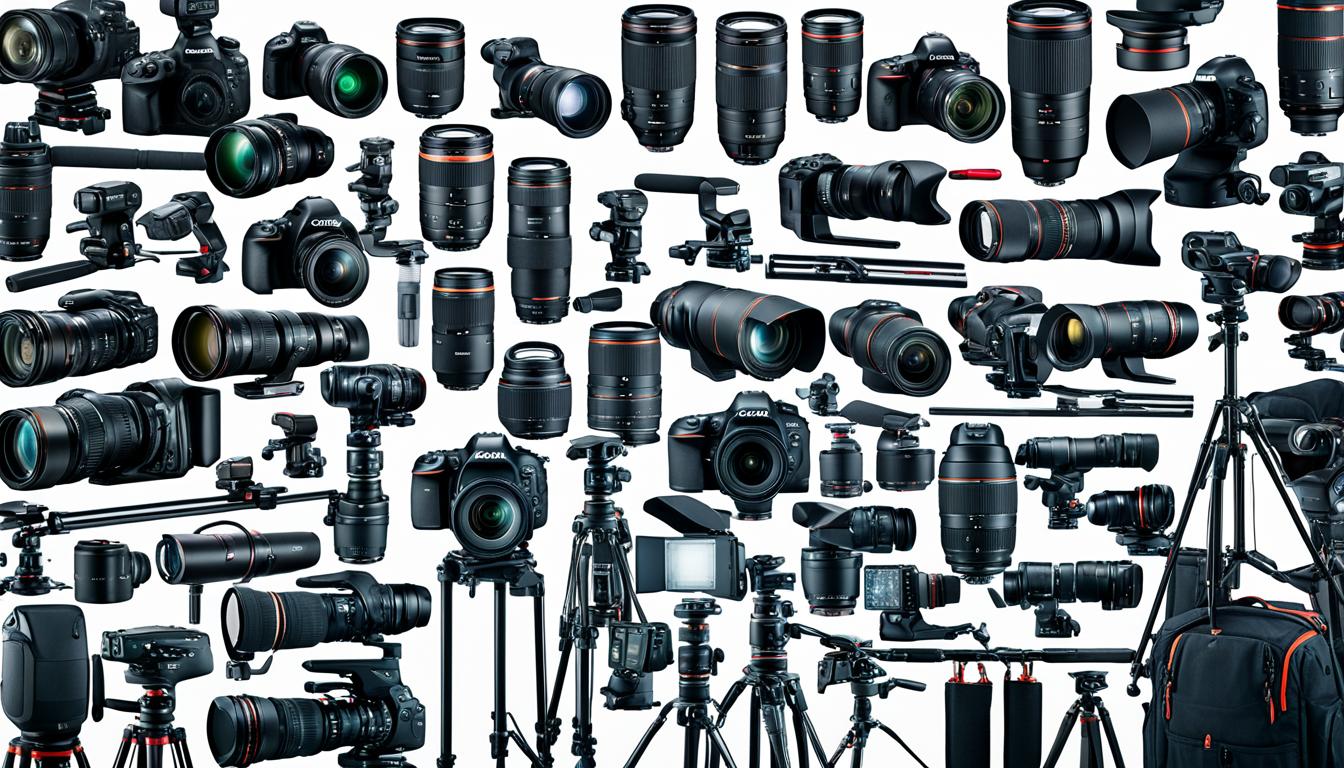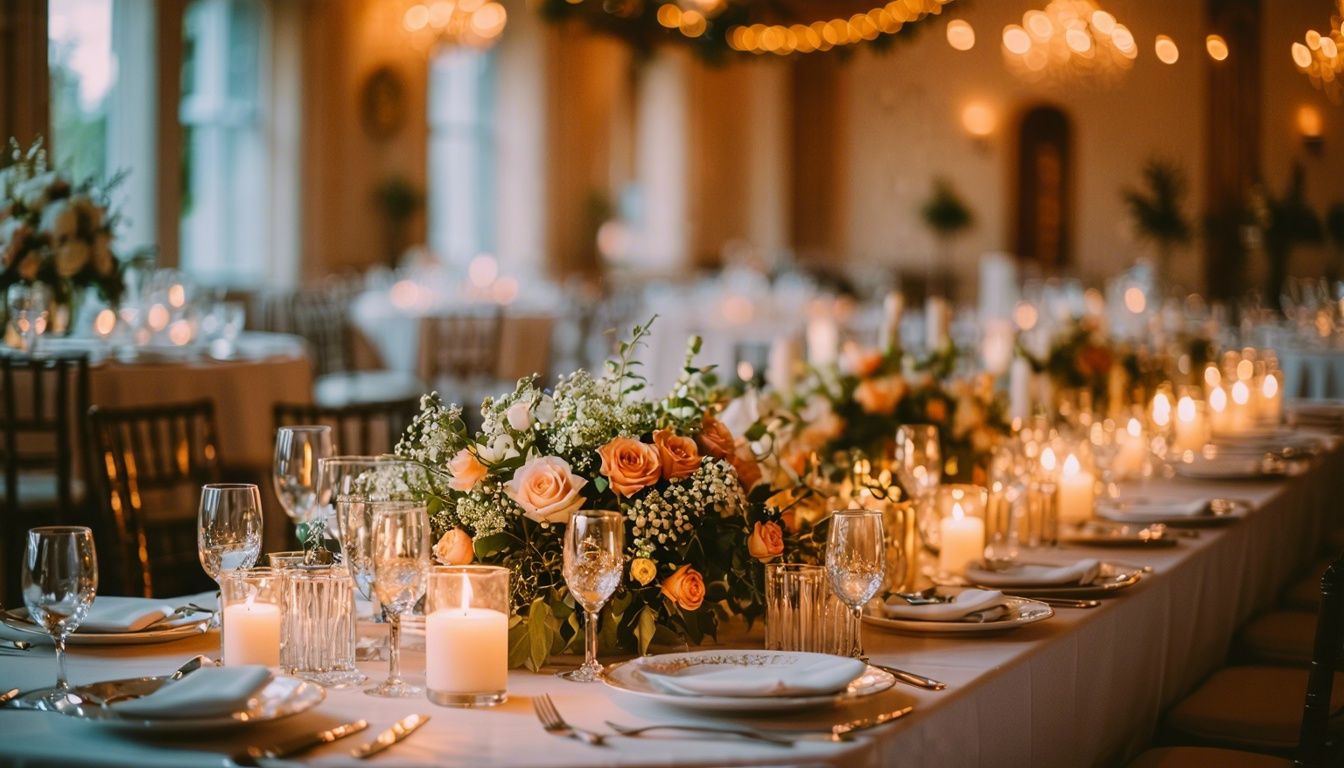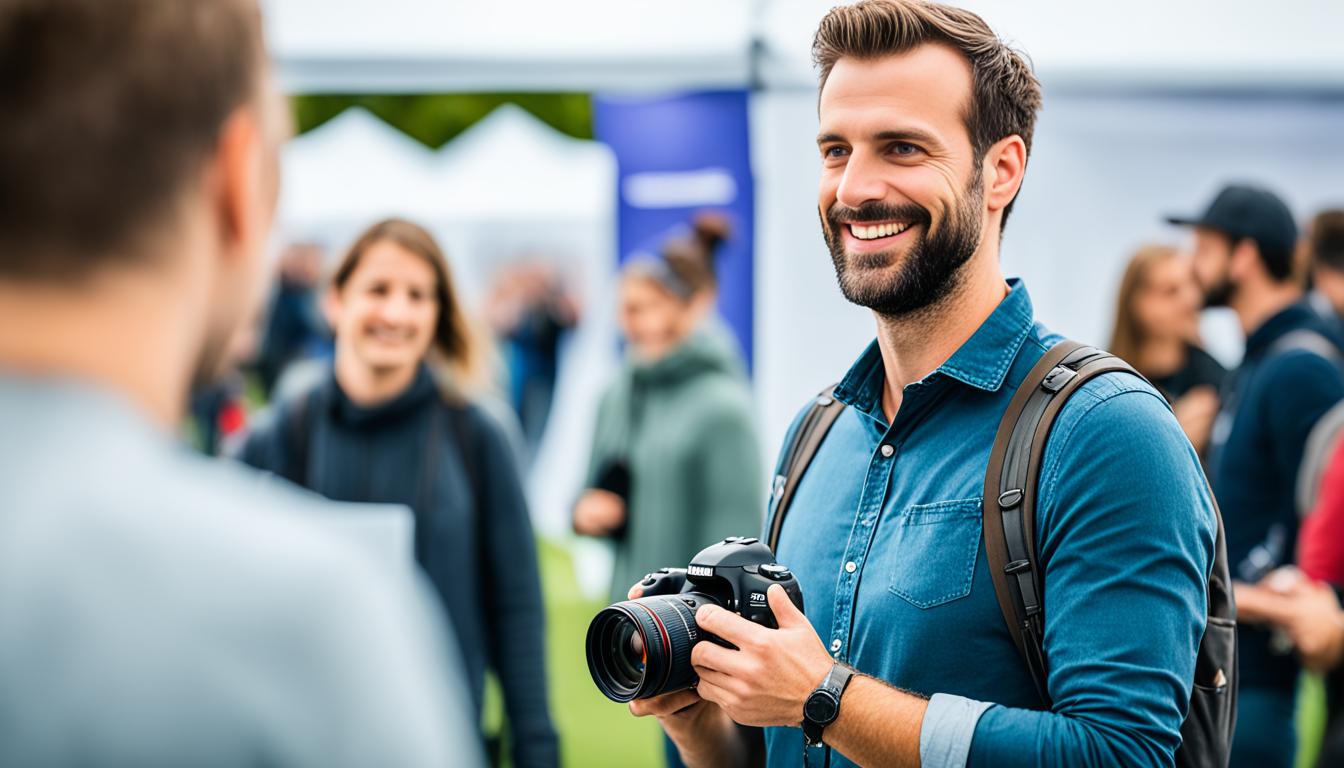The event photography industry is constantly evolving, offering new opportunities for event planners and marketers. To stay ahead of the curve, we must stay informed about the latest trends and technologies in event photography. By keeping up with the updates, we can ensure that our photo experiences are engaging, memorable, and relevant to today’s audiences.
From Instagrammable and shareable photo experiences to immersive and interactive elements, the world of event photography has seen significant advancements in recent years. Technologies like artificial intelligence (AI) and virtual and augmented reality (VR/AR) are transforming the way we capture and share event memories. By embracing these trends and leveraging modern technology, we can create truly unforgettable experiences for attendees.
Key Takeaways
- Staying informed about event photography trends is crucial for event planners and photographers.
- Embracing new technologies like AI and VR/AR can enhance photo experiences and engagement.
- Instagrammable and shareable photo experiences are in high demand.
- Immersion and interactivity through elements like 360° cameras and projection mapping create memorable event experiences.
- Event photography is moving towards sustainability and eco-friendly practices.
The Impact of Social Media on Event Photography
Social media has revolutionized the way we share and experience events. With platforms like Instagram, Facebook, and Twitter, attendees can instantly capture and showcase their event experiences to a vast audience. The impact of social media on event photography cannot be understated. It has created a demand for photo experiences that are visually stunning, easily shareable, and designed to engage attendees.
Event photographers play a crucial role in meeting this demand by creating photo experiences that are not only Instagrammable but also shareable across various social media platforms. To achieve this, photographers need to consider elements such as vibrant backdrops, interactive props, and unique lighting that make photos visually appealing and engaging. These visual elements not only enhance the overall event experience but also encourage attendees to capture and share their moments, effectively increasing engagement and exposure for the event.
Take a look at this stunning example of a photo experience designed to capture and share event experiences:
By incorporating social media-friendly features into their photo experiences, event photographers can create experiences that foster collaboration and lasting memories among attendees. Encouraging group and mobile-first photography not only increases attendee participation but also ensures that event experiences are shared in real-time, amplifying the reach and impact of the event across social media platforms.
Engaging Attendees through Social Media
Social media not only provides a platform for sharing event experiences but also enables event planners to engage with attendees on a deeper level. By leveraging social media, event planners can create a sense of community among attendees, encourage conversations, and keep participants informed and excited about the event.
“Social media allows us to connect with attendees even after the event has ended. By engaging with them through likes, comments, and shares, we can continue to build relationships that extend beyond the event itself.”
Moreover, event planners can harness the power of social media by creating event-specific hashtags, prompting attendees to tag their photos and posts with the dedicated hashtag. This not only boosts attendee engagement but also allows event organizers to track and monitor event-related content, gaining valuable insights into attendee experiences and sentiments.
In summary, social media has had a profound impact on event photography as it has transformed the way we share our event experiences and engage with others. By creating visually appealing and shareable photo experiences, event photographers and planners can maximize attendee engagement, amplify event exposure, and create lasting memories for all.
Immersive and Interactive Elements in Event Photography
Beyond static photo booths, event photography has evolved to incorporate immersive and interactive elements that captivate guests and enhance their event experience. Technologies such as 360° cameras, AR filters, and projection mapping have taken center stage, providing attendees with unique and engaging moments to capture and share.
One of the key aspects of immersive photo experiences is the use of 360° cameras. These cameras capture the entire surroundings, allowing attendees to relive the event from different perspectives. Whether it’s a sweeping panorama of a grand ballroom or a vibrant outdoor setting, 360° cameras provide an immersive visual experience that enables attendees to feel like they are truly part of the event.

Another exciting development in event photography is the integration of augmented reality (AR) filters. AR filters overlay digital elements onto the real world, transforming ordinary photos into interactive and dynamic visuals. From playful masks and animated effects to branded overlays, AR filters bring an element of fun and creativity to event photography.
“With AR filters, event attendees can let their imagination run wild, transforming themselves into fantastical characters or adding whimsical elements to their photos. It’s like having a virtual playground at your fingertips!”
Projection mapping is yet another innovative technology that has revolutionized event photography. By projecting dynamic visuals onto various surfaces, such as walls, ceilings, and even objects, event organizers can create immersive and visually stunning environments. Projection mapping adds a new dimension to event photography, enveloping attendees in a fully immersive experience.
These immersive and interactive elements not only enhance the overall event atmosphere but also create memorable moments for attendees to capture and share. By incorporating technologies such as 360° cameras, AR filters, and projection mapping, event photographers can elevate their craft and provide participants with extraordinary photo experiences.
| Immersive and Interactive Elements | Benefits |
|---|---|
| 360° Cameras | Allows attendees to relive the event from different perspectives |
| AR Filters | Transforms ordinary photos into interactive and dynamic visuals |
| Projection Mapping | Creates visually stunning environments with dynamic visuals |
Sustainable and Eco-Friendly Practices in Event Photography
At our events, we prioritize sustainable and eco-friendly practices to reduce our environmental impact. By incorporating eco-conscious strategies into event photography, we strive to create memorable experiences while being mindful of the planet. Our commitment to eco-friendly event photography is evident in our use of upcycled materials, digital alternatives to prints, and carbon-offsetting initiatives.
Using Upcycled Materials
One of the ways we promote sustainability is by utilizing upcycled materials for our photo experiences. By repurposing items that would otherwise go to waste, we reduce the demand for new resources and minimize our ecological footprint. Our creative team transforms discarded materials into unique backdrops, props, and photo booth structures, adding a touch of eco-friendliness to every event.
Digital Alternatives to Prints
Gone are the days of printed photographs piling up after an event. We offer digital alternatives to prints, allowing attendees to access their photos effortlessly. Through our user-friendly online platforms, guests can easily download and share their pictures on social media or store them digitally, saving both paper and energy. This digital approach not only minimizes waste but also promotes the convenience and accessibility of event photography.
Carbon-Offsetting Initiatives
We understand the carbon footprint associated with events and take responsibility for offsetting our emissions. As part of our commitment to sustainability, we participate in carbon-offsetting initiatives. By investing in renewable energy projects and supporting reforestation efforts, we ensure that our events have a positive environmental impact. It’s our way of giving back to the planet and making a difference in the fight against climate change.
“Our commitment to eco-friendly event photography is evident in our use of upcycled materials, digital alternatives to prints, and carbon-offsetting initiatives.”
By adopting sustainable and eco-friendly practices, we not only contribute to a greener future but also inspire attendees to make conscious choices themselves. Our eco-friendly event photography approach sets a positive example, encouraging others to prioritize sustainability in their own events. Together, we can create memorable experiences that leave a positive impact on both guests and the planet.
| Benefits of Sustainable Event Photography | Examples | Impact |
|---|---|---|
| 1. Reduces waste and resource consumption | Using upcycled materials for backdrops and props | Minimizes the demand for new resources |
| 2. Eliminates the need for physical prints | Providing digital alternatives for attendees | Reduces paper waste and energy consumption |
| 3. Offsets carbon emissions | Investing in renewable energy projects | Contributes to a greener future and fights climate change |
Personalized Photo Experiences for Attendees
The rise of social media has revolutionized the way we share and document our experiences. Attendees now crave personalized photo experiences that capture their unique personalities and provide shareable content. To meet this demand, event planners are leveraging the power of artificial intelligence (AI) to create customized photo collages and offer custom backgrounds that resonate with attendees.
AI technologies have transformed event photography by incorporating features like face detection, automated cropping, and real-time filters. These advancements enhance the quality and variety of event photo experiences, providing a personalized touch for every attendee. With AI in event photography, we can ensure that each individual feels seen and represented in their event photos.
Imagine attending a conference and stepping into a photo booth that instantly recognizes your face and suggests personalized backgrounds based on your interests or preferences. Whether it’s a stunning nature scene or a vibrant cityscape, the custom backgrounds create a truly immersive and tailored experience for attendees. These personalized photo collages and backgrounds not only capture the essence of each individual but also create lasting memories that attendees are eager to share with their social media followers.
Furthermore, event planners can utilize AI to analyze attendee interactions and preferences, enabling them to deliver highly personalized and engaging photo experiences. By leveraging AI algorithms, event photographers can curate and deliver photos that align with attendees’ preferences, ensuring that every shot is meaningful and impactful.
Benefits of Personalized Photo Experiences
Personalized photo experiences offer several notable benefits:
- Improved attendee engagement: When attendees feel a personal connection to their photos, they are more likely to engage in capturing and sharing their experiences.
- Enhanced brand visibility: The unique and personalized nature of these photo experiences amplifies the reach and exposure of event brands, generating buzz and attracting a wider audience.
- Increased social media interactions: Customized photo collages and backgrounds encourage attendees to share their photos on social media platforms, sparking conversations and interactions surrounding the event.
- Memorable and shareable content: Personalized photo experiences create lasting memories for attendees and provide them with shareable content that showcases their individuality.
Personalization is the key to delivering exceptional event photo experiences. By harnessing the power of AI in event photography, event planners can create immersive and engaging moments that leave a lasting impression on attendees.
With AI-powered personalized event photography, we can ensure that attendees feel valued and connected to the event. These customized photo experiences have the power to transform events into unforgettable moments and serve as a powerful marketing tool for brands.

| Benefits of Personalized Photo Experiences |
|---|
| Improved attendee engagement |
| Enhanced brand visibility |
| Increased social media interactions |
| Memorable and shareable content |
The Future of Event Photography: 2024 Predictions and Trends
As we look ahead to the year 2024, event photography is set to undergo a significant transformation with the emergence of cutting-edge technologies and innovative trends. These advancements will revolutionize the way we capture and share moments during events, offering attendees enhanced photo experiences. Let’s explore some of the exciting predictions and trends that will shape the future of event photography.
AI-Powered Photo Booths
AI-powered photo booths will take event photography to new heights, offering attendees unique and personalized experiences. These intelligent booths will incorporate AI algorithms to instantly enhance and edit photos, creating stunning visuals in real-time. Facial recognition technology will also play a key role, allowing for seamless tagging and sharing of photos on social media platforms. With AI-powered photo booths, attendees will have access to professional-quality images that capture their best moments.
360° Cameras and Photo Spheres
The integration of 360° cameras and photo spheres will transform the way event photography is captured. These advanced cameras will enable photographers to capture immersive, panoramic images that provide a 360-degree perspective of the event. Attendees will be able to relive the event in its entirety, immersing themselves in the sights and sounds captured by these cutting-edge cameras. 360° cameras and photo spheres will revolutionize event photography, creating a truly captivating experience for both attendees and viewers.
Mirror Booths and Magic Mirrors
Mirror booths and magic mirrors will add a touch of enchantment to event photography. These interactive devices will incorporate state-of-the-art technology, allowing attendees to preview and customize their photos in real-time. Mirror booths will offer virtual props, filters, and digital enhancements, enhancing the overall photo experience. Magic mirrors, on the other hand, will provide a seamless integration of augmented reality (AR) effects, transporting attendees to magical and captivating virtual environments. Mirror booths and magic mirrors will take event photography to a whole new level, offering attendees a truly interactive and immersive experience.
AR and VR Integration
AR and VR integration will revolutionize event photography by merging the physical and digital worlds. Augmented reality (AR) will enable attendees to interact with virtual objects and characters, adding an element of fun and surprise to their photos. Virtual reality (VR), on the other hand, will transport attendees to virtual environments, allowing them to fully immerse themselves in unique and captivating experiences. The seamless integration of AR and VR into event photography will create unforgettable moments and deliver unparalleled engagement for attendees.
Facial Recognition
Facial recognition technology will simplify and enhance the photo-sharing experience at events. Attendees will no longer have to manually tag themselves or their friends in photos; instead, facial recognition algorithms will automatically identify individuals and suggest tags. This seamless integration of facial recognition technology will streamline the process of sharing event photos, making it easier for attendees to connect and engage with each other.
Cloud-Based Sharing and Storage
Cloud-based sharing and storage platforms will become the preferred method for storing and sharing event photos. These platforms will offer secure and accessible storage, allowing attendees to effortlessly access their photos anytime, anywhere. Cloud-based sharing will also enable seamless sharing on social media platforms, ensuring that attendees can instantly showcase their unforgettable moments with friends and followers.
Personalization as a Service
Personalization will become a defining factor in event photography, with personalized photo experiences tailored to each attendee. AI algorithms will analyze attendee preferences and demographics to offer customized backgrounds, filters, and photo collages. This personalized touch will create a unique and memorable experience for each attendee, enhancing their overall event experience.
In summary, the future of event photography in 2024 is filled with exciting predictions and trends. From AI-powered photo booths and 360° cameras to mirror booths and magic mirrors, AR and VR integration, facial recognition, cloud-based sharing, and personalization as a service, these advancements will revolutionize the way we capture, share, and cherish moments during events. Event planners, photographers, and attendees alike can look forward to a future where photo experiences are more immersive, interactive, and personalized than ever before.
Conclusion
Staying updated with the latest event photography trends and embracing new technologies is crucial in today’s evolving industry. As event planners and photographers, it is essential for us to stay informed and be experimental in our approach. By doing so, we can meet and exceed client expectations, maintain relevance, and find inspiration for creative innovation.
The landscape of event photography is constantly changing, with new trends and technologies emerging regularly. To stay ahead of the curve, we need to actively seek out information and learn about the latest advancements. Whether it’s incorporating AI-powered photo booths, 360° cameras, or AR and VR integration, embracing these new technologies can elevate our photo experiences and create memorable moments for event attendees.
As the industry evolves, so do the expectations of event attendees. To meet their needs and provide personalized and immersive experiences, we must adapt and embrace new technologies. By doing so, we can enhance our services, stay relevant, and create unforgettable memories for our clients and their guests. Stay updated, embrace new technologies, and be a part of the ever-evolving event photography industry.
FAQ
How can event planners and photographers stay updated with the latest trends in event photography?
Event planners and photographers can stay updated with the latest trends in event photography by staying informed through industry publications, attending photography conferences and workshops, following influential photographers and event planners on social media, and actively seeking out new technologies and techniques.
What impact does social media have on event photography?
Social media has a significant impact on event photography, as it has become a primary channel for sharing event experiences. Photo experiences that are easily shareable online increase engagement and exposure for the event and help create lasting memories for attendees.
How can event photographers create Instagrammable and shareable photo experiences?
Event photographers can create Instagrammable and shareable photo experiences by providing vibrant backdrops, interactive props, unique lighting, and incorporating elements that encourage collaboration among attendees. These elements make the photos more visually appealing and encourage attendees to capture and share their experiences.
What are some immersive and interactive elements that can be incorporated into event photography?
Immersive and interactive elements that can be incorporated into event photography include using 360° cameras to capture panoramic photos, using augmented reality (AR) filters to add digital overlays to photos, and utilizing projection mapping to create dynamic visual displays during events.
How can event organizers implement sustainable and eco-friendly practices in event photography?
Event organizers can implement sustainable and eco-friendly practices in event photography by using upcycled materials for photo experiences, providing digital alternatives to prints, and implementing carbon-offsetting initiatives. These practices reduce waste and demonstrate a commitment to environmental responsibility.
How can event planners offer personalized photo experiences for attendees?
Event planners can offer personalized photo experiences for attendees by leveraging technologies like artificial intelligence (AI) to offer personalized photo collages or custom backgrounds. AI technologies such as face detection, automated cropping, and real-time filters enhance the quality and variety of event photo experiences, providing a personalized touch for attendees.
What are the predicted trends in event photography for 2024?
The predicted trends in event photography for 2024 include the rise of AI-powered photo booths, the use of 360° cameras and photo spheres, the popularity of mirror booths and magic mirrors, the integration of augmented reality (AR) and virtual reality (VR), the use of facial recognition technology, the adoption of cloud-based sharing and storage, and the emergence of personalization as a service.
How can event planners and photographers embrace new technologies in event photography?
Event planners and photographers can embrace new technologies in event photography by actively seeking out innovative solutions, experimenting with new techniques, attending tech-focused workshops and conferences, and collaborating with technology providers. Embracing new technologies helps professionals stay relevant and find inspiration for creative innovation in the dynamic event photography industry.
How Can Event Photography Trends and Technology Impact Marketing and Pricing in the Business?
Event photography marketing pricing can be heavily influenced by the latest trends and technology. Businesses must stay current with popular styles and equipment to stay competitive. Utilizing the latest technology can lead to higher quality images, which may justify premium pricing. Marketing efforts should also reflect current trends to attract potential clients.




